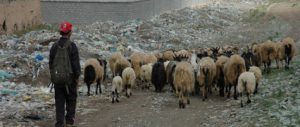The Sanjiangyuan – or “Three Rivers Source” – region of Qinghai, western China, contains the headwaters of three major waterways: the Yangtze, Mekong and Yellow River. In 2005, China’s central government launched a seven-year, 7.5-billion yuan (US$1.2 billion) project to protect and strengthen the ecology of the area, which is a designated national nature reserve. One of the programme’s key measures has been to move nomadic herders into new migrant villages. These “ecological migrants” now number over 50,000, accounting for one quarter of the reserve’s entire population
Over the last few years, we have made many trips to affected areas to learn how the project is being implemented. On visits to Hainan, Yushu, Guoluo and Huangnan, for example, we have seen for ourselves the ecological and social benefits the changes have brought to the region. But this is an ambitious social-engineering scheme, and its problems have also been manifold.
The provision of adequate public services is one of the biggest challenges. Infrastructure in some of the relocation sites is excellent, just like in a modern town. But in some cases, basic amenities including water, electricity, roads, schools, toilets and healthcare facilities, not to mention television, have not kept pace with the rising population. These services have a direct impact on migrants’ lives, and their absence makes it harder to attract inhabitants, as well as making future development work much harder.
In Guoluobanma county, for example, the influx of migrants has put serious pressure on the local healthcare system: the county hospital cannot cope with the increased numbers, while the Tibetan medicine hospital has no inpatient beds. The nearest alternatives are distant. The town of Dawu is 320 kilometres away, and Xining, the provincial capital, 786 kilometres away. Access to medical care has become a major issue for local people.
Housing projects built by the local government are mostly located on the outskirts of towns. We have seen places with cable television wired up – but no electricity, or vice versa. Even when television is available, the herders don’t watch it much, as many of them don’t speak Mandarin. And of course, they can’t easily communicate with the rest of the community. Existing residents tend not to welcome the newcomers, and there’s little sense of kinship or belonging.
Just getting by is hard. The herders used to live by moving their herds around the grasslands, finding fresh grass and water, but relocation has taken away their livelihood: they are not herders anymore, but nor are they farmers or urban workers, and low incomes have become a major problem. A few have gone elsewhere to find work, or now make a living collecting caterpillar fungus, used in Chinese medicine, but most rely on an annual 3,000-yuan to 6,000-yuan (US$474 to US$947) “fodder subsidy” from the government.
A family of five living in one of the towns struggles to maintain a basic standard of living on this sum. Don’t even mention milk and meat; buying dung for heating alone costs 2,000 yuan (US$316) each year, 3,000 yuan (US$474) in some places, and the government’s annual heating subsidy is only 1,000 yuan (US$158). The herders complain that everything has got more expensive over the past two years: a bag of cow dung has gone from three yuan to 10 yuan (US$0.47 to US$1.60) and a jin of butter has risen from 12 yuan to 20 yuan (US$1.90 to US$3.20). The only thing that hasn’t gone up is the subsidies.
The herders had expected to live comfortable lives in the towns; they put a lot of faith in the local government. They never expected that they would not only lose their original way of life, but also suffer what they call the “four hardships”: not being able to afford meat, milk, butter tea or heating fuel. The herders’ standard of living is generally lower now than it was before – and much lower than that of other locals. In Guoluo, a typical migrant’s income is around a fifth of that of an established resident. Poor locals, moreover, receive government welfare; not so poor migrants.
If the ecological migrants are to have stable and successful urban lives and not return to the grasslands, it is crucial that they have a way to make a living. This is the biggest challenge for local government. Hard-pressed officials say they have managed to provide some temporary work for those in urgent need and been able to increase some incomes. But this is no long-term solution. It will be hugely difficult to lift the herders out of poverty, due to two main factors.
First, the level of education and skills possessed by the herders is low. Almost all are completely illiterate and know little but herding. Even if the government funded training courses, it is too much to hope that a 800-yuan fee and 10 days of education would provide migrants with a living. There are also some herders who, finding no honest work since relocation, have turned to crime, disrupting public order. Certain migrant neighbourhoods have come to be seen as “no-go areas” by locals.
Second, regional economic conditions don’t help. Southern Qinghai is underdeveloped and has little capacity to absorb new arrivals. There are few sources of work, and many school and college graduates struggle to find work – the market just doesn’t have jobs for hastily trained herders.
The migrants aren’t the only ones feeling resentful: inadequate compensation for displaced farmers has also stirred disquiet. Between 2003 and 2007, farmland in affected counties was requisitioned to make space for herder settlement projects. But the prices paid were lower than market rates.
In Yushu prefecture, for example, prices have been high for years: land sells for 70,000 yuan to 100,000 yuan (US$11,000 to US$15,800) per mu in Jiegu township and Nangqên county and for 50,000 yuan to 70,000 yuan (US$7,900 to US$11,000) per mu around Xisan county town (a mu is 667 square metres). But the funds put up by the provincial government were much lower: 16,000 yuan to 18,000 yuan (US$2,500 to US$2,800) per mu was paid in Yushu and Nangqên counties, and only 3,000 yuan (US$474) per mu in the four other counties affected. The farmers have complained of unfair treatment.
In the village of Xiangda, in Nangqên county, virtually everyone lost their land and several thousand people across the prefecture now struggle to make ends meet. These people are not ecological migrants – they have not been relocated – but they are demanding the same treatment as those who are. They too have made sacrifices for the sake of protecting the ecology of Sanjiangyuan, and the government should not ignore their hopes and needs.
Guan Guixia and Suonan Wangjie are teachers at the Qinghai Provincial Committee Communist Party School.
Homepage image by Beth Walker



